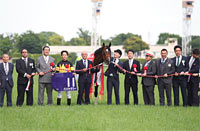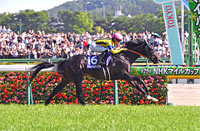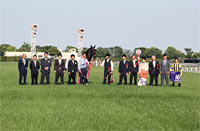2015 News
Data Analysis for the “2015 NHK Mile Cup (G1)”3-year-old mile champion decider opens the door to a glittering future In 2004, King Kamehameha was crowned the leading horse of his generation by scoring back-to-back wins in the NHK Mile Cup and the Tokyo Yushun (Japanese Derby). Again, four years later in 2008, Deep Sky triumphed in both this race and the following Japanese Derby. As these examples show, this unmissable race not only decides the champion 3-year-old miler but also offers hints for the “festival of racing” that is the Japanese Derby. This time, let’s dig out some traits common to successful runners in this race from results over the last 10 years. Dark horses often shine! On checking aggregate performances by favoritism over the last 10 years, runners backed as “1st favorite” turn out to have won five times and amassed a top 2 ratio of 60.0%. Of the other five winners, one came into this race as “2nd favorite”, one as “3rd favorite”, and three as “10th favorite or lower”. Although the favored horses often win, a total of ten runners backed as “10th favorite or lower” have finished in the top 3. So it’s worth remembering that dark horses often sneak into the first few places in this race. [Table 1] [Table 1] Performance by favoritism (last 10 years)
Hints from the performance by bracket number As for the performance by bracket number over the last 10 years, a characteristic feature is that no winner has emerged from the innermost and outermost brackets, i.e. brackets “1” and “8”. Oddly, though, bracket “1” has the best top 3 ratio with 25.0%. What’s more, horses in bracket “8” have been runners-up for three straight years since 2011, and the two horses in bracket “1” finished 2nd and 3rd last year. So it should be noted that brackets “1” and “8”, though not producing a winner, have proven somewhat more successful recently. [Table 2] [Table 2] Performance by bracket number (last 10 years)
Check the distances of the last three outings Turning next to the performance of runners over the last 10 years by starts in 1,600m+ turf races in their last three outings, horses that contested turf races over 1,600m or more in each of their last three outings have achieved the best success ratios. Of 78 runners in this “3 starts” category, 19 have finished in the top 3, compared to only 11 of 102 horses with “2 starts or fewer”. This merely underlines the superiority of horses with a consistent record of racing over distances of 1,600m or more in their most recent outings. The venue for this race – the 1,600m turf course at Tokyo – is often said to demand toughness in addition to speed. For this reason if none other, our attention should be on horses that have mainly contested distances of at least a mile recently. [Table 3] [Table 3] Performance by starts in 1,600m+ turf races in the last three outings (last 10 years)
Also check recent race conditions and highest finish If we aggregate the performances of runners over the last 10 years in terms of their highest finish in open-class turf races run over 1,600-1,800m within their last three outings, we find that all ten winning horses had experienced a top 3 finish in a race answering to those conditions. In particular, runners with experience of a “1st” place have produced eight winners, and far outshine the other groups in terms of their win ratio. This year, too, it might be an idea to check for runners with successful recent records in open-class turf races run over 1,600-1,800m. [Table 4] [Table 4] Performance by highest finish in open-class turf races run over 1,600-1,800m within the last three outings (last 10 years)
Seek out the winners! All six winners since 2009 had passed the 4th corner in “5th position or higher” in their previous race. Although some past winners of this race had been positioned towards the rear at the 4th corner last time out, those among the leaders at the 4th corner in their previous race have been ascendant in recent years. [Table 5] [Table 5] Winners' position at the 4th corner in the previous race (last 6 years)
(Data analysis by Michio Kawano) |
|



















